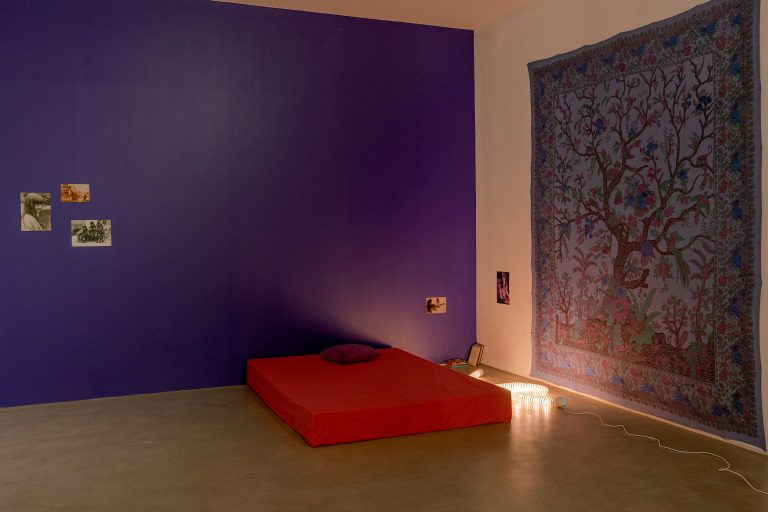Rainbow Body
2018 - Film & Video (Film & Video)
2:07 minutes
Chitra Ganesh
The title of Rainbow Body by Chitra Ganesh refers to an elevated state of, or metaphor for, the consciousness transformation known as a rainbow body. The Buddhist master Padmasambhava achieved this state from his union with Mandarava, a female spirit (dakini) and princess in Tantric Buddhism. Through study and physical connection, each played a key role in the other’s enlightenment. Ganesh’s work takes inspiration from the cave on the right in the painting of the bodhisattva Maitreya, located adjacent to the animation. The cave structure is elaborated upon the extensively built out, introducing an interior depth where the ultimate transformation happens. The animation opens with Mandarava waking up to a dream in her bedroom and follows her journey through the Bardo, the sometimes terrifying passageway between death and rebirth. The aerial and gliding camera movements reconfigure imagery of the Bardo from paintings with a greater sense of space and depth. The work also combines the artist’s line drawings, watercolors, and paintings with pictorial elements from a variety of original sources.
Spanning printmaking, sculpture, and video, Chitra Ganesh’s work draws from broad-ranging material and historic reference points, including surrealism, expressionism, Hindu, Greek and Buddhist iconographies, South Asian pictorial traditions, 19th-century European portraiture and fairy tales, comic books, song lyrics, science fiction, Bollywood posters, news and media images. The process of automatic writing is central to the practice of the Indian-American artist and emerges from dissecting myths to retrieve critical moments of abjection, desire, and loss. By layering disparate materials and visual languages, Ganesh considers alternate narratives of sexuality and power.
Colors:
Related works of genres: » feminist artists, » lgbt artists from the united states
» see more

© » KADIST
Glenn Ligon
2000Glenn Ligon’s diptych, Condition Repor t is comprised of two side-by-side prints...

© » KADIST
Juliana Huxtable
2017Herculine’s Prophecy by Juliana Huxtable features a kneeling demon-figure on what appears to be a screen-print, placed on a wooden table, which has then been photographed and digitally altered to appear like a book cover, with a title and subtitle across the top, and a poem written across the bottom...

© » KADIST
Félix González-Torres
1992Behind the simplicity and beauty of this untitled photograph of a brilliantly-colored flowerbed by Félix González-Torres are two remarkable stories of love, loss, and resilience...

© » KADIST
Lynn Hershman Leeson
2017Using the seminal 1958 film Vertigo as a launchpad, Lynn Hershman Leeson explores the blurred lines between fact and fantasy in VertiGhost , a film commissioned by the Fine Arts Museums in San Francisco...
Other related works, blended automatically
» see more

© » KADIST
Chitra Ganesh
2018Silhouette in the Graveyard is part of a suite of animated videos by Chitra Ganesh titled The Scorpion Gesture ...
Related works sharing similar palette
» see more

© » WHITEHOT
Kyle Staver: Truth Be Told at Half Gallery advertise donate post your art opening recent articles cities contact about article index podcast main February 2024 "The Best Art In The World" "The Best Art In The World" February 2024 Kyle Staver: Truth Be Told at Half Gallery Kyle Staver, Amazon Archers, 2023...
Other works by: » Chitra Ganesh
» see more

© » KADIST
Chitra Ganesh
2018Silhouette in the Graveyard is part of a suite of animated videos by Chitra Ganesh titled The Scorpion Gesture ...

© » KADIST
Chitra Ganesh
2010Rabbithole by Chitra Ganesh is a digital animation that refigures a fundamental plot device in myths and fables...

© » KADIST
Chitra Ganesh
2018Art of War 1, City in Broad Daylight, Leaving the House, Justice is a Virtue, and Lions are Stronger than Men are linocut prints from the series Sultana’s Dream ...
Related works found in the same semantic group
» see more

© » KADIST
Jessica Warboys
2013The ongoing “Sea Paintings” series is central to the practice of Jessica Warboys...






